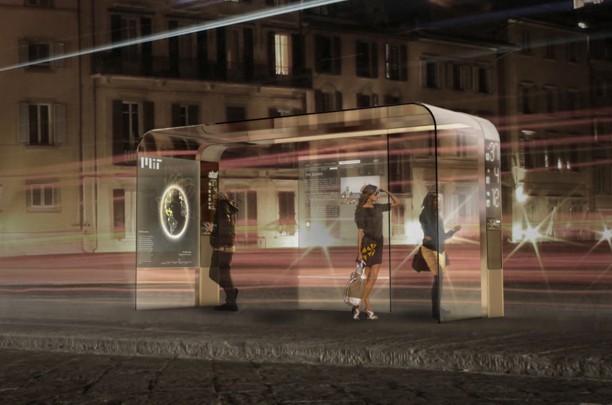Bushaltestelle der Zukunft des MIT schafft Abwechslung
MIT-Forscher zeigen mit EyeStop eine neue Generation
 Mit der lokalen Bus-Haltestelle können, E-Mail und Co abgerufen werden.
Mit der lokalen Bus-Haltestelle können, E-Mail und Co abgerufen werden.
MIT Architekten und Ingenieure stellten einen Entwurf für eine solche Haltestelle, auf dem Genio Fiorentino Festival in Florenz, Italien vor.
EyeStop, entwickelt vom Massachusetts Institute of City Lab, verkürzt die Wartezeiten an Bushhaltestellen und Vitrinen mit dem Potenzial der nächsten Design-Generation.
MIT researchers unveil the EyeStop
„Bus stop of the future“ can sense its surroundings
Imagine if your local bus stop allowed you to check your e-mail, share community information on a digital message board or monitor the local air quality? And perhaps best of all, what if it could tell you the exact location of that bus that you’re waiting for?
MIT architects and engineers just unveiled a design for such a bus stop, at the Genio Fiorentino festival in Florence, Italy.
EyeStop and developed by the MIT SENSEable City Lab, it takes the tedium out of waiting for the bus and showcases the potential of next-generation urban transportation design. The EyeStop is partially covered with touch-sensitive e-INK and screens, and features state-of-the art sensing technologies and a variety of interactive services. Riders can plan a bus trip on an interactive map, surf the Web, monitor their real-time exposure to pollutants and use their mobile devices as an interface with the bus shelter. They can also post ads and community announcements to an electronic bulletin board at the bus stop, enhancing the EyeStop’s functionality as a community gathering space.
„The EyeStop could change the whole experience of urban travel,“ said Carlo Ratti, Head of the SENSEable City Lab at MIT. „At the touch of a finger, passengers can get the shortest bus route to their destination or the position of all the buses in the city. The EyeStop will also glow at different levels of intensity to signal the distance of an approaching bus.“
[ad#PR-Messeservice]
In addition to displaying information, the bus stop also acts as an active environmental sensing node, powering itself through sunlight and collecting real-time information about the surrounding environment. „EyeStop is like an ‚info-tape‘ that snakes through the city,“ said project leader Giovanni de Niederhausern. „It senses information about the environment and distributes it in a form accessible to all citizens.“ Unlike the typical mass-produced bus stop, EyeStop is designed to fit the physical characteristics of its surroundings. A computer program generates a unique design for each bus stop, providing both optimal sheltering for users and maximum sunlight exposure for power generation. Simple materials like steel, glass and gray local stone („pietra serena,“ as it is called locally), together with its minimalist design, will help the EyeStop blend into the historic urban fabric of Florence, or wherever else it might be deployed. „Since the Renaissance, there has been an interplay between the physical form of the city (urb) and its citizenship (civitas),“ added Carlo Ratti. „Today’s technologies are adding new possibilities to that age-long relationship, thanks to the addition of digital information to physical space. It is as if a new materiality were emerging in architecture, with the seamless blending of bits and atoms.“
EyeStop was developed at the SENSEable City Laboratory by Giovanni de Niederhausern, Shaocong Zhou, Assaf Biderman and Carlo Ratti, in collaboration with the Province of Florence and the local public transportation authority ATAF.
http://senseable.mit.edu/eyestop/
